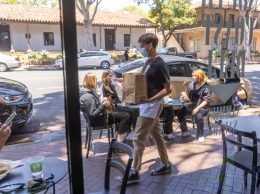Is the Central Coast headed toward a COVID-19 peak or is an April surge in our future?
That is the key question amid signs that decisions by state and local governments to reduce social interaction in early March are starting to pay off.
At press time the most alarming signals were coming from Santa Barbara County, where cases of COVID-19 more than doubled from 47 to 111 during the five days from March 27 to April 1. And from Ventura County, which saw cases jump 92 percent from 83 to 160 during the same period.
However, San Luis Obispo County, which had seen an early surge, saw the rate of increase slow to a little more than 40 percent as cases rose from 59 to 83 during the five days.
If social distancing and remote work are going to pay off for the region, the next two weeks will be critical. That is when we will know if resources are adequate to the job and if San Luis Obispo County can avoid fatalities — a remarkable data point so far. There was one death in Santa Barbara County and five in Ventura County at press time.
An analysis by the The Institute for Health Metrics and Evaluation at the University of Washington suggests that early measures are paying off.
It predicts demand for hospital rooms, ICUs and ventilators will peak on April 28 for California as a whole. If the projections hold, there will be sufficient rooms and equipment on a statewide basis.
Although those projections don’t drill down to the county level, reporting by Tony Biasotti in a recent edition of the Business Times suggests there is additional capacity in the form of empty space in older building available at many regional hospitals, particularly for non-COVID-19 patients.
Across the region, attention has begun to focus on prisons in Lompoc, county jails and large state institutions in Atascadero, where a single infected person could send things spiraling out of control. Likewise, smaller communities such as New Cuyama are experiencing their first patients — a troubling development in an area with relatively few medical resources.
We’re giving the region a solid “B” for keeping its citizens healthy and averting the kind of calamities that have befallen Colorado ski towns, small cities in Georgia and parts of Louisiana, notable hot spots in non-urban areas.
But it is going to be up to all of us to make social distancing and working remotely work — for weeks if not months ahead.
ECONOMIC COLLAPSE IS REAL
When it comes to the economy, lights continue to flash red. Companies continue to shed workers, durable goods orders are down and the end of social distancing is nowhere in sight.
So far, aside from streaming services and online juggernauts like Facebook and Amazon, there are few winners in this economic meltdown.
A more orderly sell off in the stock market suggests that the investment community has begun to adjust to the idea of a slow recovery once restrictions on travel and commerce begin to get lifted. But whereas a few weeks ago many were either in denial or counting on a miracle cure, reality seems to be setting in.
As any good behavioral economist will tell you, facing up to reality is the first step in what could be a long road to recovery.






 Print
Print Email
Email

















